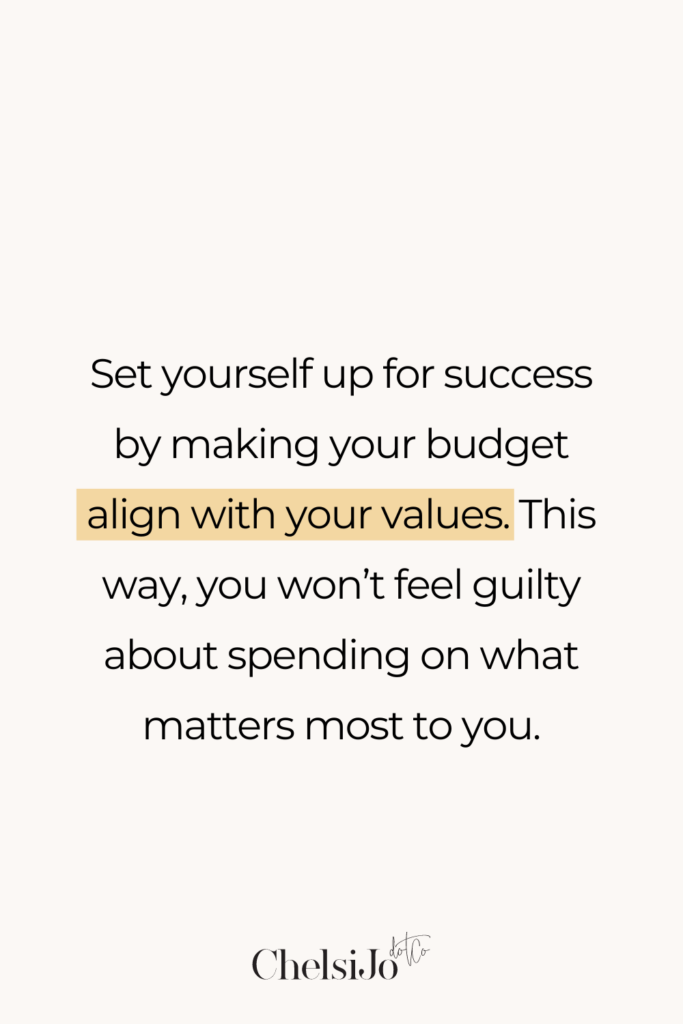Welcome back, friends! I’m thrilled you’re here for another deep dive into the systems that can transform your life. Today, we’re tackling something BIG: budgeting. And not just any budgeting – a budgeting system that’s simple, powerful, and, most importantly, effective.
You’re going to learn a budgeting hack that’s so easy, you can implement it immediately and start watching your savings grow. It’s the same system that pulled us out of living paycheck to paycheck, and it’s the one we still use today. Let’s jump in.
Listen Below For The Entire Episode On The Systemize Your Life Podcast
Living Like No One Else Today, So You Can Live Like No One Else Tomorrow
A long time ago, my husband Blaine and I made a decision: we didn’t want to spend our lives worried about money, constantly trying to keep up with everyone else. That led us to follow a simple yet profound philosophy from Dave Ramsey: “If you live like no one else today, you can live like no one else tomorrow.”
At the time, we were scraping by. Every month felt like a juggling act, and let’s be real – it wasn’t easy. But we made a commitment to live differently so that our future could look different. We weren’t just budgeting to survive; we were budgeting to thrive. Now, we’re financially secure, and I’m sharing this journey with you so you can experience the same freedom.
The Two Key Ingredients to Financial Success
When we started listening to interviews with successful entrepreneurs and people living lives outside the norm, we noticed two things every single time:
- Grow your income by taking risks.
- Buffer those risks by saving wisely.
The first one scared me. I wasn’t sure we could take risks when we were just trying to get by, but I realized that growing your income can be about smart risks, not reckless ones. And buffering those risks by creating a solid safety net? That’s where budgeting comes in.
Why Every Budgeting System Failed – Until Now
We tried everything. Apps, spreadsheets, digital tracking – you name it. Nothing seemed to stick. Every month was a mess of trying to piece together where our money had gone, and it felt like we’d never get ahead. That is until we stumbled upon something so simple, we were shocked it worked: a cash envelope system.
But here’s the thing – we took that envelope system and made it even better with a few key tweaks. And today, I’m going to share the exact steps that will help you take control of your budget and start saving immediately.

#1: Categorize Your Spending
The first step is breaking down your expenses into categories. This is a crucial step because it helps you see exactly where your money is going each month. Grab a pen and paper, or use a digital tool, and list all your spending categories.
Start with the essentials like:
- Rent/mortgage
- Utilities
- Groceries
- Transportation
- Debt payments (if applicable)
Then, move on to non-essential spending, like:
- Entertainment
- Subscriptions
- Eating out
- Hobbies
You’ll also want to include less frequent expenses that may not happen every month, like car maintenance or annual insurance payments. Break these down into monthly estimates by dividing the total cost by 12 (if it’s annual) or 3 (if it’s quarterly). This ensures you’re prepared when those bills hit.
Pro tip: Look through the last 3 months of your bank statements to ensure you don’t miss anything. You might be surprised by what you’re actually spending.
If you’re not giving your money direction, it will control you, and that’s when the overwhelm sets in.
#2: Track Every Expense
This is where many budgeting attempts fall apart: tracking every single expense. But don’t worry—it’s not as hard as it sounds, and it’s absolutely essential for your financial success.
For one month, keep a record of every purchase you make, from your rent or mortgage payment down to that $4 latte. You can use a simple notebook, a budgeting app like YNAB or EveryDollar, or even an Excel sheet to do this.
Why is this important? Because this is where you’ll see your spending patterns. Maybe you’re spending more on takeout than you realized, or those $10-a-month subscriptions have added up over time. You need to see where your money is going so you can adjust. Just like blocking your time ensures productivity, tracking your expenses ensures financial clarity. Read more about time blocking.
#3: Build a Percentage-Based Budget
Now, here’s where my system really stands out: we use a percentage-based budget. This method allows you to stay flexible with your budget regardless of how much money comes in each month. Instead of assigning dollar amounts, you assign percentages to each category based on your income.
Here’s how you do it:
- List your income. If your income fluctuates, use an average from the last few months.
- Assign percentages for each spending category. This way, if your income increases, your budget adjusts automatically. Here’s a simple example:
- Housing: 25-30%
- Groceries: 10-15%
- Transportation: 5-10%
- Debt repayment/savings: 10-20%
- Entertainment: 5-10%
- Miscellaneous: 5-10%
Pro tip: Start small with savings if you’re just getting started. Allocating even 2% of your income to savings is better than nothing! As your budget improves, increase that percentage.
Example: If you earn $2,000 this month, your breakdown might look like:
- Housing: $600 (30%)
- Groceries: $200 (10%)
- Transportation: $100 (5%)
- Debt/Savings: $400 (20%)
- Entertainment: $100 (5%)
- Miscellaneous: $200 (10%)
By using percentages, you adjust automatically to good or bad months without overextending. Having a successful budget is crucial to having a calm life where finances aren’t kinking up the system. That’s why a budget template with my exact system is included in the Systemize Your Life program.
#4: Watch Your Savings Grow
Here’s where you take control of your future. Start saving by reallocating small percentages from your other categories. This method makes it easier to save without feeling deprived.
Start with something manageable. For example, take 1-2% from entertainment or eating out and move that to your savings. You’ll be surprised how quickly your savings start to grow! For additional tips on increasing your savings, check out my blog post on 3 Essential Grocery Shopping Tips To Stretch Your Budget
Here’s how to get started:
- Look at your current percentages and ask yourself, “Where can I cut back?” Maybe you’re spending 10% on eating out – can you drop that to 8% and move the 2% to savings?
- Automate your savings. Set up an automatic transfer so that as soon as your paycheck hits, that percentage goes directly to your savings account. It’s a “set it and forget it” strategy that will help your savings grow without you thinking about it.
- Increase over time. Once you’re comfortable with saving 2%, aim to increase it by another 1-2% every few months. Eventually, you’ll build a savings cushion without feeling the pinch.
Pro tip: Use your savings percentage to build a buffer fund (1-2 months of expenses). Once that’s done, you can start saving for bigger goals, like vacations, home repairs, or even investments.
#5: Track and Adjust Monthly
Budgeting isn’t a one-time thing—it’s an ongoing process. At the end of each month, review your spending and make small adjustments as needed. This is the step that ensures you stay on track long term. Budgeting, like time management, is an ongoing process that requires regular review and adjustment. Learn how to manage your time better in this time management blog post.
Here’s how to do it:
- Compare your actual spending to your budgeted percentages. Did you overspend on groceries but underspend on transportation? Adjust for next month.
- Shift funds if necessary. For example, if you had extra money left over in one category, move it to your savings or toward paying off debt.
- Stay flexible. Life happens. If an emergency expense comes up, don’t panic. Adjust your budget to cover the cost and move forward.
Pro tip: Reward yourself when you hit budgeting milestones! It could be something small, like enjoying a guilt-free movie night or splurging on a treat within your entertainment budget.

Stick to It, This System Will Change Your Life
This system isn’t just about surviving month-to-month. It’s about setting yourself up for long-term success. Every single student I’ve coached who has followed these steps has seen their finances turn around. Yes, it takes some time and effort, but the peace of mind that comes with financial security is absolutely worth it.
If you’re thinking, “This sounds great, but I need help putting it all together,” I’ve got you covered. Right now, I’m offering my entire budgeting system for free as part Systemize Your Life! When you join you receive my complete home management system, including the budgeting template, time blocks, and more.
Start Today and Secure Your Future
The key to all of this? Start today. Implement these steps, begin tracking your expenses, and watch your savings grow. Remember, you’re building a foundation for a future where you’re in control of your money, not the other way around.


Frequently Asked Questions
How do I start budgeting when I feel overwhelmed?
tart by focusing on one simple step at a time. The key is to create a basic structure where you list all your essential spending categories—like groceries, housing, and transportation—and allocate a specific percentage of your income to each. If you’re feeling overwhelmed, consider cutting back in non-essential areas, such as entertainment or dining out, and use those savings to build an emergency fund or reduce debt. Don’t forget, Systemize Your Life includes my complete budget system template with all the goodies to help you plug and play to create your own family budget!
How can I stay consistent with budgeting?
Consistency is all about finding a routine. One great tip is to set aside a specific time each week to review your budget. This might look like using a time-block system to regularly check in on your finances and adjust where needed. It’s not about being perfect every month, but about building the habit of tracking your spending and making small improvements as you go.
What is a simple way to save money on groceries each month?
One of the easiest ways to save on groceries is by meal planning. Start by taking stock of what’s already in your pantry and fridge, and plan your meals around those items. Then, make a list before heading to the store and stick to it! This approach will not only save you money but also cut down on food waste.
Learn more about how to streamline this process in the Meal Planning to Save Time and Money post.


